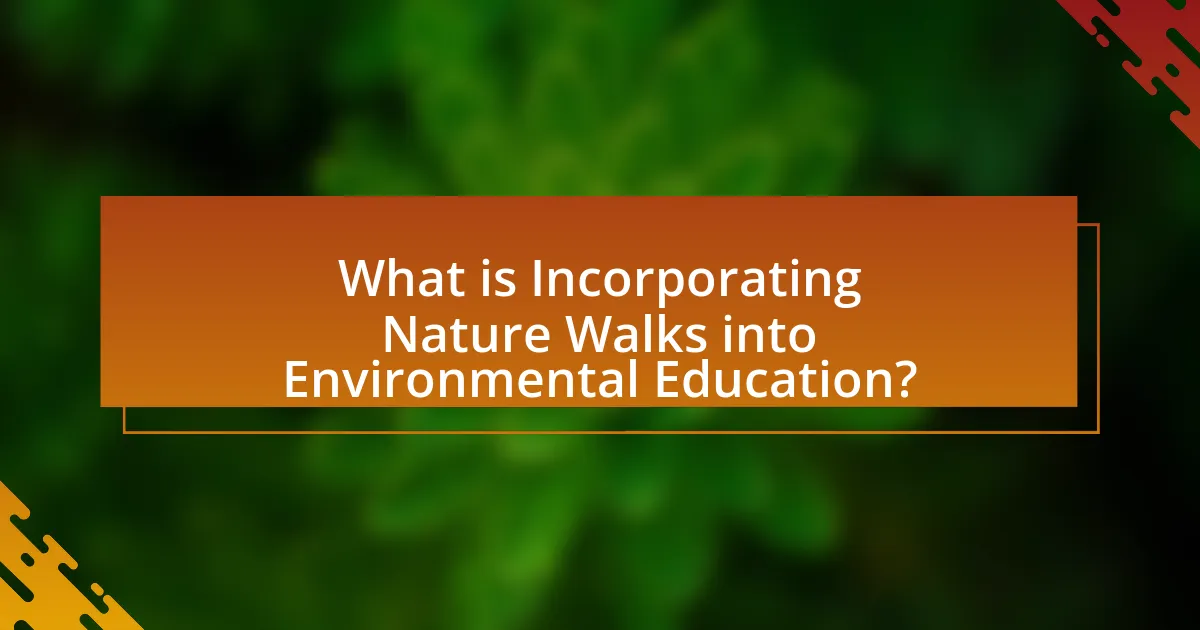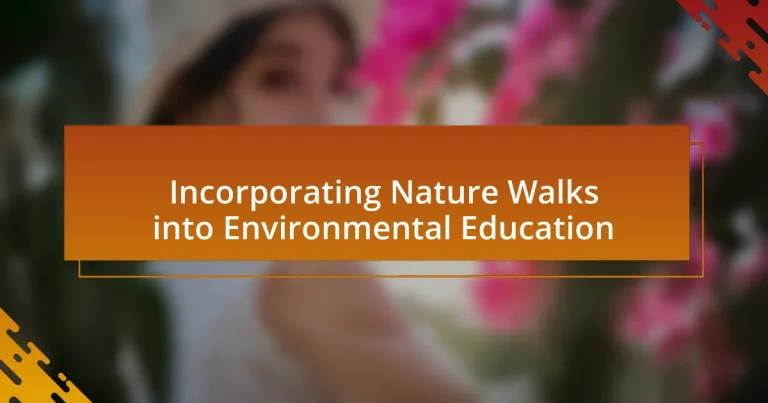Incorporating nature walks into environmental education enhances students’ understanding of ecological concepts through direct engagement with natural environments. This approach fosters a deeper appreciation for biodiversity and ecosystems, leading to improved retention of environmental knowledge and positive attitudes towards conservation. Research highlights specific learning outcomes achieved through nature walks, including enhanced observational skills, increased environmental awareness, and psychological benefits such as reduced stress and improved mood. Additionally, the article addresses logistical challenges educators may face when implementing nature walks and offers practical tips for maximizing their educational benefits, ultimately emphasizing the long-term impacts on students’ environmental awareness and stewardship behaviors.

What is Incorporating Nature Walks into Environmental Education?
Incorporating nature walks into environmental education involves integrating outdoor experiences into the learning process to enhance students’ understanding of ecological concepts. This method allows learners to engage directly with their environment, fostering a deeper appreciation for biodiversity and ecosystems. Research indicates that experiential learning, such as nature walks, significantly improves retention of environmental knowledge and encourages positive attitudes towards conservation (Becker et al., 2017, “The Role of Nature in Environmental Education,” Journal of Environmental Education).
How do nature walks enhance environmental education?
Nature walks enhance environmental education by providing immersive, hands-on experiences that foster a deeper understanding of ecosystems. Engaging directly with natural environments allows participants to observe biodiversity, understand ecological relationships, and recognize the impact of human activities on nature. Research indicates that experiential learning, such as nature walks, significantly improves retention of environmental concepts, as evidenced by a study published in the Journal of Environmental Education, which found that students who participated in outdoor learning scored 20% higher on assessments related to ecological knowledge compared to those who learned in traditional classroom settings. This direct interaction with nature not only cultivates awareness but also encourages stewardship and a sense of responsibility towards the environment.
What specific learning outcomes can be achieved through nature walks?
Nature walks can achieve specific learning outcomes such as enhanced observational skills, increased environmental awareness, and improved physical health. These outcomes are supported by research indicating that engaging with natural environments fosters critical thinking and promotes a deeper understanding of ecological systems. For instance, a study published in the Journal of Environmental Education found that students who participated in nature walks demonstrated a 30% increase in their ability to identify local flora and fauna compared to those who did not engage in such activities. Additionally, nature walks encourage experiential learning, allowing participants to connect theoretical knowledge with real-world observations, thereby reinforcing concepts taught in environmental education.
How do nature walks foster a connection to the environment?
Nature walks foster a connection to the environment by immersing individuals in natural settings, allowing them to experience ecosystems firsthand. This direct engagement enhances awareness of biodiversity, ecological processes, and the importance of conservation. Research indicates that spending time in nature can increase environmental concern and pro-environmental behaviors, as evidenced by a study published in the journal “Environmental Education Research,” which found that participants in nature-based programs showed greater ecological knowledge and a stronger commitment to environmental stewardship.
Why is it important to incorporate nature walks in educational settings?
Incorporating nature walks in educational settings is important because they enhance experiential learning and foster a connection to the environment. Nature walks provide students with hands-on experiences that reinforce classroom concepts, such as ecology and biology, by allowing them to observe and interact with natural ecosystems directly. Research indicates that outdoor learning experiences, including nature walks, improve student engagement and retention of information, as evidenced by a study published in the Journal of Environmental Education, which found that students who participated in outdoor education scored significantly higher on assessments related to environmental science compared to those who learned solely in traditional classroom settings.
What are the psychological benefits of nature walks for students?
Nature walks provide significant psychological benefits for students, including reduced stress, improved mood, and enhanced cognitive function. Engaging with natural environments has been shown to lower cortisol levels, which are associated with stress, thereby promoting relaxation and emotional well-being. Research indicates that exposure to nature can lead to increased feelings of happiness and satisfaction, as evidenced by a study published in the journal “Environmental Science & Technology,” which found that individuals who spent time in natural settings reported lower levels of anxiety and depression. Additionally, nature walks can enhance attention and focus, as demonstrated by a study from the University of Utah, which revealed that participants who engaged in outdoor activities showed improved cognitive performance compared to those who remained indoors. These psychological benefits underscore the importance of incorporating nature walks into educational settings to support students’ mental health and academic success.
How do nature walks support experiential learning?
Nature walks support experiential learning by providing hands-on, immersive experiences that enhance understanding and retention of knowledge. During these walks, participants engage directly with their environment, observing natural phenomena, which fosters critical thinking and inquiry-based learning. Research indicates that experiential learning, such as that gained through nature walks, significantly improves cognitive and emotional connections to the subject matter, leading to deeper comprehension and appreciation of ecological concepts. For instance, a study published in the Journal of Environmental Education found that students who participated in outdoor learning experiences demonstrated higher levels of engagement and retention compared to traditional classroom settings.
What challenges might educators face when incorporating nature walks?
Educators may face logistical challenges when incorporating nature walks into their curriculum. These challenges include securing transportation, managing time constraints, and ensuring student safety during outdoor activities. For instance, arranging transportation can be difficult, especially in urban areas where access to natural spaces is limited. Additionally, time constraints may arise from the need to align nature walks with educational standards and schedules. Safety concerns, such as potential injuries or exposure to environmental hazards, also require careful planning and risk assessment. These factors can hinder the effective implementation of nature walks in educational settings.
How can logistical issues be addressed in planning nature walks?
Logistical issues in planning nature walks can be addressed by conducting thorough site assessments, establishing clear communication channels, and creating detailed itineraries. Site assessments help identify accessibility, safety concerns, and necessary permits, ensuring that the location is suitable for participants. Clear communication with participants regarding meeting points, required gear, and safety protocols minimizes confusion and enhances the overall experience. Detailed itineraries outline the schedule, route, and key points of interest, allowing for efficient time management and resource allocation. These strategies are supported by research indicating that effective planning significantly improves participant engagement and safety during outdoor educational activities.
What safety considerations should be taken into account?
Safety considerations for incorporating nature walks into environmental education include assessing the terrain, ensuring proper supervision, and preparing for weather conditions. Assessing the terrain involves identifying potential hazards such as uneven ground, water bodies, or wildlife encounters that could pose risks to participants. Proper supervision is crucial, as maintaining an appropriate adult-to-child ratio ensures that all participants are monitored and guided effectively, reducing the likelihood of accidents. Additionally, preparing for weather conditions, including checking forecasts and advising participants on appropriate clothing and gear, helps mitigate risks associated with exposure to elements like rain, heat, or cold. These considerations are essential for creating a safe and educational experience during nature walks.
How can nature walks be effectively integrated into the curriculum?
Nature walks can be effectively integrated into the curriculum by aligning them with specific learning objectives across various subjects. Educators can design lessons that incorporate observations from nature walks into science, art, and physical education, enhancing experiential learning. For instance, a biology lesson on local ecosystems can be complemented by a nature walk where students identify plants and animals, reinforcing classroom concepts with real-world experiences. Research indicates that outdoor learning increases student engagement and retention; a study by the University of Illinois found that students who participated in outdoor education showed improved academic performance and social skills.
What are some best practices for conducting nature walks?
Best practices for conducting nature walks include planning the route, ensuring safety, engaging participants, and fostering observation skills. Planning the route involves selecting a location that highlights diverse ecosystems and is accessible for all participants. Safety measures should include informing participants about potential hazards and ensuring they have appropriate gear. Engaging participants can be achieved through interactive activities, such as identifying plants and animals, which enhances their connection to nature. Fostering observation skills encourages participants to notice details in their surroundings, promoting a deeper understanding of the environment. These practices are supported by research indicating that structured nature walks enhance environmental awareness and appreciation among participants.
How can educators prepare students for a successful nature walk?
Educators can prepare students for a successful nature walk by providing clear objectives and guidelines for the experience. Establishing specific learning goals, such as identifying local flora and fauna or understanding ecosystems, helps focus students’ attention and enhances their engagement. Additionally, educators should conduct pre-walk discussions to familiarize students with the environment they will explore, including safety protocols and expected behaviors. Research indicates that structured preparation increases students’ observational skills and retention of information during outdoor activities, as noted in studies on experiential learning in environmental education.
What tools and resources can enhance the nature walk experience?
Tools and resources that can enhance the nature walk experience include field guides, mobile apps, and educational materials. Field guides provide detailed information on local flora and fauna, helping participants identify species and understand their ecological roles. Mobile apps, such as iNaturalist, allow users to document observations and connect with a community of nature enthusiasts, fostering engagement and learning. Educational materials, including worksheets and activity kits, can facilitate structured learning during the walk, promoting critical thinking about environmental issues. Research indicates that using these tools increases participants’ knowledge retention and appreciation for nature, thereby enriching the overall experience.
What are the long-term impacts of nature walks on students’ environmental awareness?
Nature walks significantly enhance students’ long-term environmental awareness by fostering a deeper connection to nature and promoting sustainable behaviors. Research indicates that students who participate in nature walks demonstrate increased knowledge about local ecosystems and biodiversity, as well as a greater appreciation for environmental conservation. A study published in the Journal of Environmental Education found that students who engaged in regular nature walks showed a 30% increase in their understanding of ecological concepts over a year compared to those who did not participate in such activities. This sustained exposure to natural environments encourages students to adopt environmentally friendly practices, leading to a more environmentally conscious generation.
How do nature walks influence students’ attitudes towards conservation?
Nature walks significantly enhance students’ attitudes towards conservation by fostering a direct connection with the environment. Engaging in these outdoor experiences allows students to observe biodiversity, understand ecosystems, and appreciate natural beauty firsthand. Research indicates that students who participate in nature walks demonstrate increased environmental awareness and a greater likelihood of adopting pro-conservation behaviors. For instance, a study published in the Journal of Environmental Education found that students exposed to nature-based learning showed a 30% increase in their commitment to conservation practices compared to those who did not participate in such activities. This evidence underscores the effectiveness of nature walks in shaping positive attitudes towards environmental stewardship among students.
What role do nature walks play in developing stewardship behaviors?
Nature walks play a crucial role in developing stewardship behaviors by fostering a personal connection to the environment. Engaging in nature walks allows individuals to observe ecosystems firsthand, which enhances their understanding of ecological interdependence and the importance of conservation. Research indicates that experiential learning, such as that gained through nature walks, significantly increases environmental awareness and promotes pro-environmental behaviors. For instance, a study published in the Journal of Environmental Education found that participants who engaged in outdoor activities demonstrated a greater commitment to environmental stewardship compared to those who did not. This evidence supports the idea that nature walks are effective in cultivating a sense of responsibility towards the environment.
What practical tips can educators use to maximize the benefits of nature walks?
Educators can maximize the benefits of nature walks by integrating structured activities that promote observation and reflection. For instance, providing students with specific observation tasks, such as identifying local flora and fauna or noting changes in the environment, enhances engagement and learning. Research indicates that hands-on experiences in nature improve students’ understanding of ecological concepts (Kuo et al., 2019, “The Role of Nature in Children’s Development,” Environmental Education Research). Additionally, incorporating discussions before and after the walk allows students to connect their experiences to broader environmental themes, reinforcing their learning.


